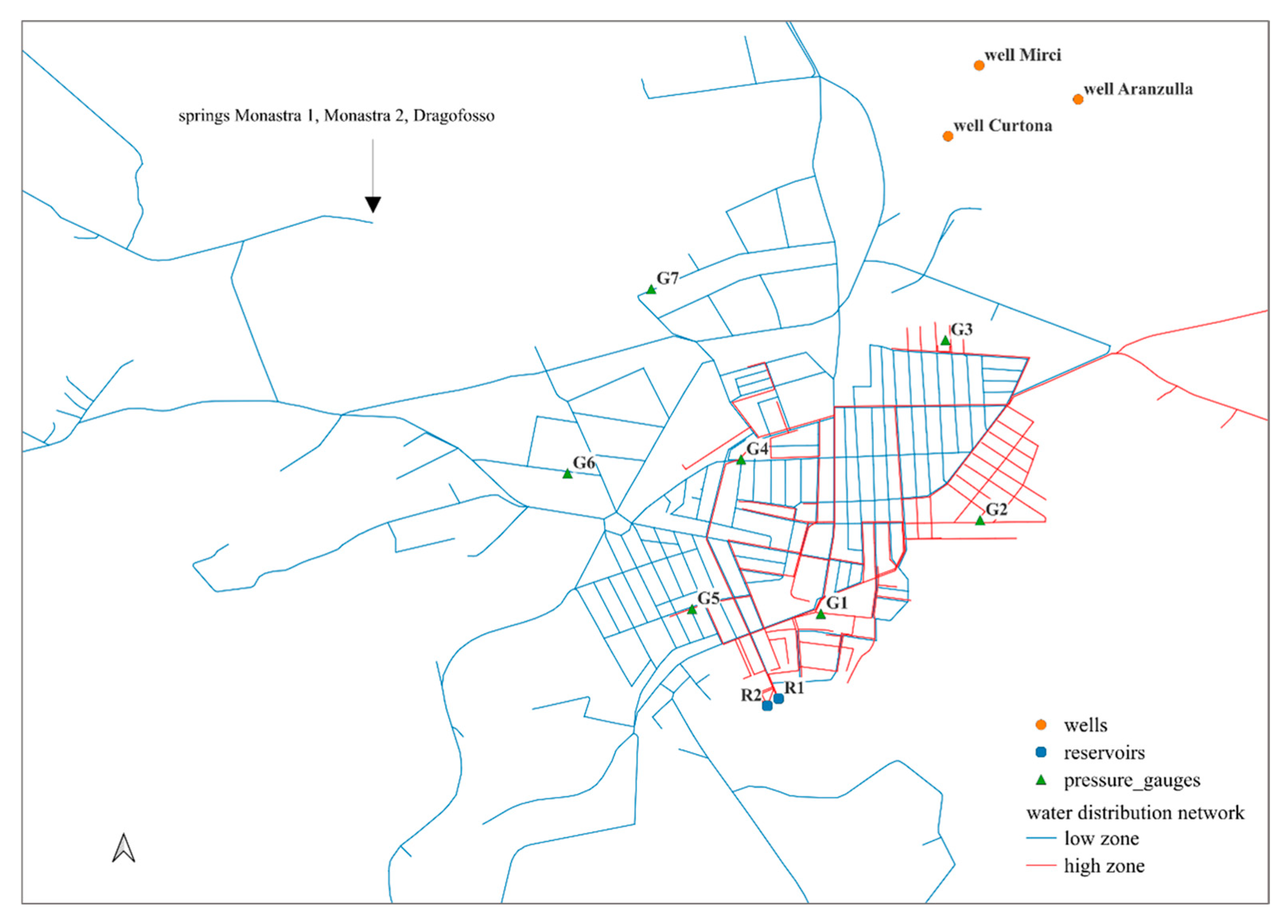Simulation of a Case-Study Intermittent Water Distribution Network by Using the Storm Water Management Model †
Abstract
:1. Introduction
2. Materials and Methods
2.1. Case Study
2.2. Model Setup
3. Results
Author Contributions
Funding
Institutional Review Board Statement
Informed Consent Statement
Data Availability Statement
Conflicts of Interest
References
- De Marchis, M.; Fontanazza, C.M.; Freni, G.; La Loggia, G.; Napoli, E.; Notaro, V. A model of the filling process of an intermittent distribution network. Urban Water J. 2010, 7, 321–333. [Google Scholar] [CrossRef]
- Mohan, S.; Abhijith, G.R. Hydraulic Analysis of Intermittent Water-Distribution Networks Considering Partial-Flow Regimes. J. Water Resour. Plan. Manag. 2020, 146, 04020071. [Google Scholar] [CrossRef]
- Gullotta, A.; Butler, D.; Campisano, A.; Creaco, E.; Farmani, R.; Modica, C. Optimal Location of Valves to Improve Equity in Intermittent Water Distribution Systems. J. Water Resour. Plan. Manag. 2021, 147, 04021016. [Google Scholar] [CrossRef]
- Gullotta, A.; Campisano, A.; Creaco, E.; Modica, C. A Simplified Methodology for Optimal Location and Setting of Valves to Improve Equity in Intermittent Water Distribution Systems. Water Resour. Manag. 2021, 35, 4477–4494. [Google Scholar] [CrossRef]
- Suribabu, C.R.; Sivakumar, P. Analysis of Intermittent Water Distribution Networks Using a Dummy Emitter Device at Each Demand Node. J. Pipeline Syst. Eng. Pract. 2023, 14, 06023003. [Google Scholar] [CrossRef]
- Suribabu, C.R.; Sivakumar, P.; Sivakumar, N. Volume driven analysis for house level water supply assessment in an intermittent water supply system. ISH J. Hydraul. Eng. 2023, 29, 459–467. [Google Scholar] [CrossRef]
- Campisano, A.; Gullotta, A.; Modica, C. Using EPA-SWMM to simulate intermittent water distribution systems. Urban Water J. 2019, 15, 925–933. [Google Scholar] [CrossRef]
- Campisano, A.; Gullotta, A.; Modica, C. An Expeditious Campaign of Field Experiments for Preliminary Analysis of the Hydraulic Behavior of Intermittent Water Distribution Networks. Water 2023, 15, 1102. [Google Scholar] [CrossRef]
- Thornton, J.; Lambert, A. Progress in Practical Prediction of Pressure/Leakage, Pressure/Burst Frequency and Pressure/Consumption Relationships. In Proceedings of the IWA Special Conference ‘Leakage 2005’, Halifax, NS, Canada, 12–14 September 2005. [Google Scholar]


Disclaimer/Publisher’s Note: The statements, opinions and data contained in all publications are solely those of the individual author(s) and contributor(s) and not of MDPI and/or the editor(s). MDPI and/or the editor(s) disclaim responsibility for any injury to people or property resulting from any ideas, methods, instructions or products referred to in the content. |
© 2024 by the authors. Licensee MDPI, Basel, Switzerland. This article is an open access article distributed under the terms and conditions of the Creative Commons Attribution (CC BY) license (https://creativecommons.org/licenses/by/4.0/).
Share and Cite
Gullotta, A.; Campisano, A. Simulation of a Case-Study Intermittent Water Distribution Network by Using the Storm Water Management Model. Eng. Proc. 2024, 69, 192. https://doi.org/10.3390/engproc2024069192
Gullotta A, Campisano A. Simulation of a Case-Study Intermittent Water Distribution Network by Using the Storm Water Management Model. Engineering Proceedings. 2024; 69(1):192. https://doi.org/10.3390/engproc2024069192
Chicago/Turabian StyleGullotta, Aurora, and Alberto Campisano. 2024. "Simulation of a Case-Study Intermittent Water Distribution Network by Using the Storm Water Management Model" Engineering Proceedings 69, no. 1: 192. https://doi.org/10.3390/engproc2024069192
APA StyleGullotta, A., & Campisano, A. (2024). Simulation of a Case-Study Intermittent Water Distribution Network by Using the Storm Water Management Model. Engineering Proceedings, 69(1), 192. https://doi.org/10.3390/engproc2024069192






